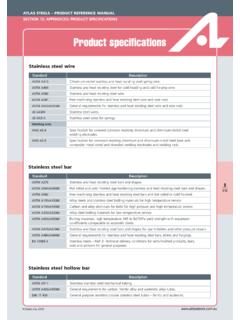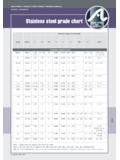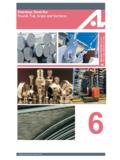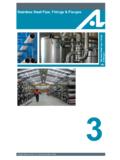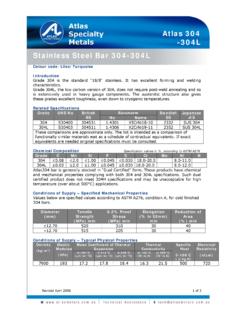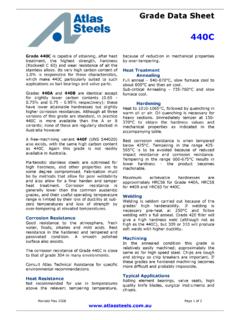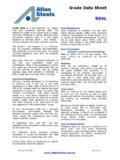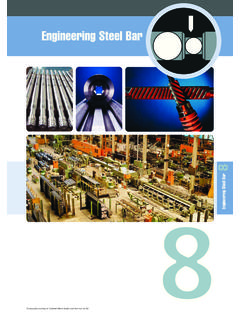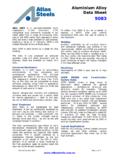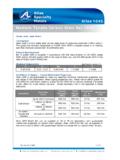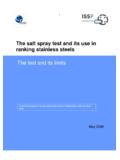Transcription of The Atlas Steels Technical Handbook of Stainless …
1 The Atlas Steels Technical Handbook of Stainless Steels Copyright Atlas Steels Revised : August 2013. Produced by Atlas Steels Technical Department Atlas Steels Technical Handbook of Stainless Steels FOREWORD. This Technical Handbook has been produced as an aid to all personnel of Atlas Steels , their customers and the engineering community generally. It is intended to be both background reading for Technical seminars conducted by Atlas Steels Technical Department, and also as a source of ongoing reference data. Any suggestions for improvements, additions or corrections would be very welcome; these should be directed to: Technical Manager, Atlas Steels Telephone +61 3 8383 9863, email Copies of this Handbook can be downloaded from the Atlas Steels web site at Details of specific products are given in the Atlas Steels Product Reference Manual , the series of Atlas Grade Data Sheets and in Atlas Technotes, as listed below; copies of all these can be viewed or downloaded from the Atlas Steels Website.
2 Atlas Steels Technotes 1. Qualitative Sorting Tests for Steels 2. Pitting & Crevice Corrosion of Stainless Steels 3. Stainless Steels - Properties & Equivalent Grades 4. Machining of Stainless Steels 5. Cleaning, Care & Maintenance of Stainless Steels 6. Life Cycle Costing 7. Galvanic Corrosion 8. "L", "H" and Standard Grades of Stainless Steels 9. Stainless steel Tube for the Food Industry 10. Restrictions of Hazardous Substances (RoHS). 11. Magnetic Response of Stainless Steels 12. Pipe Dimensions 13. AtlasCR12 & AtlasCR12Ti the 12% Chromium Ferritic Stainless Steels 14. Aluminium Alloys 5052 and 5251 Quite Similar but Completely Different Atlas Grade Datasheets Concise datasheets, covering all the common Stainless Steels , include chemical composition, mechanical and physical properties, fabrication and application of each grade.
3 Again these are available from the Atlas Steels Website. Information from any Atlas publications can be freely copied, but it is requested that the source be acknowledged. Atlas Steels Technical Department Atlas Steels Technical Department comprises experienced metallurgists, based at our Melbourne Head Office. We offer a free information service, including: Metal grade selection Fabrication information Special Steels applications Specification assistance (such as equivalents of foreign specifications and trade names). Metallurgical properties of metals Supply of Technical literature published by Atlas Steels and other metals institutions and bodies. We also have our own metallurgical laboratory providing facilities to assist in investigation of products and applications. This assistance is provided as a free service to Atlas Steels ' valued customers, and to all members of the Australian and New Zealand engineering community.
4 Email Limitation of Liability The information contained in this Technical Handbook is not an exhaustive statement of all relevant information. It is a general guide for customers to the products and services available from Atlas Steels and no representation is made or warranty given in relation to this information or the products or processes it describes. Published by Atlas Steels Technical Department Copyright Atlas Steels Page 2. Atlas Steels Technical Handbook of Stainless Steels TABLE OF CONTENTS. Hardening 30. FOREWORD 2 Stress Relieving 30. Atlas Steels Technotes 2 Surface Hardening 31. Atlas Grade Datasheets 2. SURFACE FINISHING 32. Atlas Steels Technical Department 2. Limitation of Liability 2 Passivation 32. Pickling 32. TABLE OF CONTENTS 3 Degreasing 33. Electropolishing 33. THE FAMILY OF MATERIALS 4 Grinding and Polishing 33.
5 steel Grade Designations 4 Mechanical Cleaning 34. Blackening 34. Stainless Steels - INTRODUCTION TO. SURFACE CONTAMINATION IN. THE GRADES AND FAMILIES 6. FABRICATION 35. The Families of Stainless Steels 6. Austenitic Stainless Steels 6 Contamination by Carbon steel 35. Ferritic Stainless Steels 7 Contamination by Chlorides 35. Martensitic Stainless Steels 7 Contamination by Carbon 35. Duplex Stainless Steels 7 DESIGN CONSIDERATIONS IN. Precipitation Hardening Stainless Steels 7 FABRICATION OF Stainless Steels 36. Characteristics of Stainless Steels 7. Standard Classifications 7 Grade Selection for Fabrication 36. Austenitic and Duplex Stainless Steels 8 Design to Avoid Corrosion 36. Ferritic and Martensitic Stainless Steels 9 Specific Design Points - To Retain Corrosion Comparative Properties of the Stainless steel Resistance 37.
6 Alloy Families 10. GUIDELINES FOR Stainless steel GRADE. CORROSION RESISTANCE 11 SELECTION 39. General Corrosion 11. Pitting corrosion 11 APPENDICES 41. Crevice corrosion 12 Grade Summary - Stainless & Heat Resisting Stress corrosion cracking (SCC) 12 Steels 41. Sulphide Stress Corrosion Cracking (SSC) 13 Comparison of Grade Specifications of Intergranular corrosion 13 Stainless Steels 43. Galvanic corrosion 14 Typical Physical Properties - Annealed Contact corrosion 14 Condition 44. Hardness Conversions 45. HIGH TEMPERATURE RESISTANCE 16. Unit Conversions 46. Scaling Resistance 16 Dimensional Tolerances for Bar 47. Creep Strength 16 Further Information 48. Structural Stability 17 Internet Sites of Interest 49. Environmental Factors 17. Thermal Expansion 17. CRYOGENIC PROPERTIES 19. MAGNETIC PROPERTIES 20.
7 Magnetically Soft Stainless Steels 20. MECHANICAL PROPERTIES 21. Mechanical Properties of Wire 22. Mechanical Properties of Bar 22. FABRICATION 23. Forming Operations 23. Machining 25. Welding 26. Soft Soldering 27. Brazing ("Silver Soldering") 27. HEAT TREATMENT 29. Annealing 29. Page 3. Atlas Steels Technical Handbook of Stainless Steels THE FAMILY OF MATERIALS. Materials can be divided into metals and non- In a similar fashion each of the metals has to metals; the history of civilisation has largely been compete for its market share, based on categorised by the ability to work metals - hence demonstrated superiority of properties or "bronze age" and "iron age" - but until quite economics. It is therefore worth identifying the recently most large-scale construction was still in various metals available and indicating just what non-metals, mostly stone or masonry and wood.
8 Their most important features are. A basic differentiation is to divide metals into "ferrous". Today a vast number of materials compete for and "non-ferrous", ie those iron-based and all the their share of the market, with more new others. materials being added every year. Some particularly exciting developments are now Amongst the non-ferrous metals the most occurring in the fields of ceramics, plastics and important for engineering applications are the glasses and composites of these materials. The families of aluminium alloys (with very low day of the ceramic car engine is probably not all densities, high electrical and thermal conductivity, that far off - already there are some high good formability and good corrosion resistance temperature components made from the new these find applications in aircraft, high tension generation of tougher ceramics, and the modern electricity conductors, yacht masts etc) and of motor vehicle also offers many examples of the copper alloys (with very high electrical and use of engineering plastics.)
9 Recent developments thermal conductivities and ready formability these in metals have re-asserted their competitive find their principal applications in electrical wiring). position in auto engineering, in particular the use Other important non-ferrous alloys (an alloy is of aluminium and magnesium alloys. A major simply a mixture of two or more metals) are the revolution under way at present is the brasses and bronzes. replacement of much copper telecommunications cabling with glass optical fibre. For metals to The family of ferrous metals incorporates a vast compete they must be able to demonstrate number of alloys. Those alloys containing a very superior properties to their competitors. high proportion of carbon (over about 2%) are called cast irons. Virtually all of the remainder are Type Typical Alloy Typical termed Steels and these can be found in either Grade Content Uses cast form (produced by pouring molten metal into a mould of the shape of the finished part) or plain 1020 C bridges, wrought form (cast as ingots or continuous cast carbon building billets or slabs, but then hot rolled or forged to Steels frames, produce bars, plates or complex shapes such as machinery rail sections and beams).
10 They can also be formed shafts to finished shape by sintering powdered metal at low alloy 4140 C highly high temperature. Steels are categorised by their Steels Cr stressed major alloying elements (carbon, manganese, Mo shafts, chromium, nickel and molybdenum) and by the forged presence or absence of minor elements (silicon, machine sulphur, phosphorus, nitrogen and titanium), as components shown in the table in Figure 1. Stainless 304 C corrosion & high 18% Cr resistant "Micro" additions of alloys are also present in some alloy 9% Ni tanks, bolts, grades. Steels springs Atlas Steels distributes product from all four tool H13 C tools for categories (plain carbon, low alloy, Stainless and Steels Si casting and tool Steels ). Cr hot forging Mo V steel Grade Designations Designation systems for metals vary widely.
